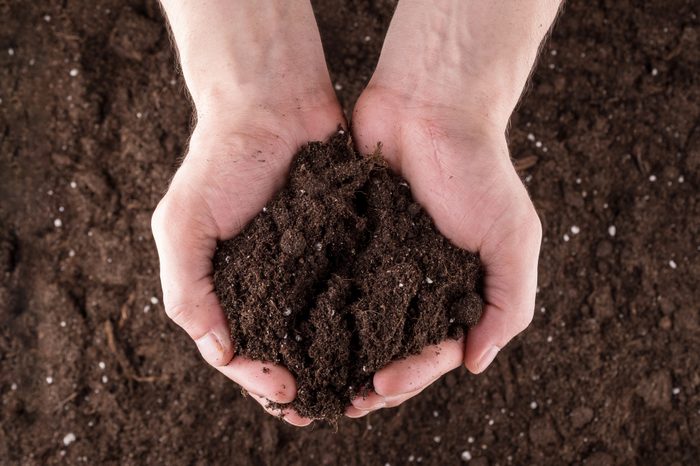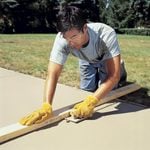Homeowner’s Guide To Soil Ecosystems

A micro-community within our soils determines how well our gardens and lawns grow. Here's what all of those tiny organisms want from you.
Our editors and experts handpick every product we feature. We may earn a commission from your purchases.
Imagine an undisturbed forest floor. Below a canopy of giant trees, a matrix of fallen leaves and dead tree trunks slowly decomposes. Over the centuries, that organic matter breaks down and enters the soil, supporting a rich web of life under the surface.
“There are billions of organisms in one ounce of soil,” says Kathy Glassey, director of renewable services at Monster Tree Service. “When there’s abundant nutrition from organic matter, those organisms are thrilled because all of their needs are met, and they can then provide everything the trees need in return.”
But when the soil is frequently disturbed, as it is in our yards and gardens, those organisms lack the conditions to properly support the plants above. This fractured ecosystem means less healthy and productive gardens. But there are ways that we can help.
On This Page
What Is a Soil Ecosystem?
A soil ecosystem — or soil food web or pedosphere — is a community of organisms interacting below the surface. When it’s healthy and balanced, it helps trees, flowers, shrubs and vegetables flourish.
We often define soil by its mineralogy, whether it’s sandy or clay-like, and its organic content, or the ability to hold moisture in the root zone.
“But the third element is the biology, the actual ecosystem and living parts of the soil,” says Mark Highland, founder and president of Organic Mechanics Soil Company and author of Practical Organic Gardening.
“I have started referring to it as the underground safari. And the most typical soil fauna that are talked about in it are the bacteria, fungi, protozoa, nematodes and micro arthropods.”
This idea of seeing soils as a living organism is relatively new, and recent soil science discoveries are just beginning to shed light on its complexities. Of the one billion bacteria in one gram of soil, only 30,000 have been formally named.
“We didn’t always know about the soil food web, the importance of soil organisms, how they cycle and recycle nutrients in our soils and protect plant roots against pathogens and stress,” says Highland. “It matters how we treat that soil ecosystem. And if we treat it like dirt, no pun intended, that soil ecosystem will not thrive.”
How Do Soil Ecosystems Differ?
Soil ecosystems differ across the country and the world, based on geology, climate and time since creation.
“The soils in Alaska are very different than the soils in the Midwest,” says Judy Daniels, a soil and geospatial scientist at Soil Sage. However, she says, “Soils that form from the same parent materials with similar climates will have similar properties around the world.”
Depending on all these conditions, one inch of soil can take 200 to 400 years to develop and up to 3,000 years to become fertile.
“Fertile soils are the key ingredient by which all life on earth depends,” says Daniels. “We are fortunate to be alive during this time in the earth’s history where soils have developed long enough to become fertile. Topsoil is a precious commodity and should be treated with extreme care.”
What Can Harm a Healthy Soil Ecosystem?
Just like building a new residential subdivision makes wildlife relocate and puts the ecosystem out of balance, some of the things we do cause soil micro-communities to collapse. These include:
- Chemicals and pesticides: “Chemicals are the number one way to harm the soil ecosystem because they harm the soil organisms,” says Daniels. “Over fertilizing soils will also disturb the nutrient cycle and add salts to the system.”
- Tilling: “Tilling kills the biology and reduces our chances of success without using synthetic products and pesticides,” says Glassey.
- Tidiness: Cleaning up plant debris breaks the lifecycle of nutrients and energy delivered to the soil. “The detritus is also important on a local and global scale in its role in the carbon cycle,” says Daniels. “Soils hold the largest portion of active carbon on earth.”
How To Support a Healthy Soil Ecosystem
While some microbes are adaptable, others require a specific set of conditions to thrive. “If anything goes outside that set, they’ll start to die off or at least go into a resting stage until optimal environmental conditions return,” says Highland. “And then they can germinate, regrow and come back.”
To help your soil return to that positive state:
-
- Get a soil test: Your soil’s organic matter content should be close to five percent, or even higher in vegetable gardens. Many state land grant universities offer soil testing services. Or you can consult your local state university cooperative extension office to find the best local soil testing option for organic matter.
- Amend the soil: Add organic matter like compost and feed your soil microbes to increase their abundance and diversity. You’ll need to mix or till the soil initially, but if you do it correctly that should be the last time you disturb it. “In the longer term, you shouldn’t need to till to plant a seed or a plug,” says Highland. “Dig the hole that you need to for the size root ball that you’re planting, and then that’s it. You don’t need to dig any deeper than that.” Highland also recommends adding a biochar amendment, which you’ll only need to do once. It’s designed to last a lifetime.
- Choose suitable plants: It’s essential to choose plants that grow well in your climate and resistant local blights. The greater the variety you plant, the more robust the below-ground biodiversity will become.
- Go organic: Without synthetic chemicals or pesticides, your garden will naturally find a diverse and healthy balance. “Often if you have a pest in your garden, nature will send the remedy,” says Highland. “So if you have aphids, most likely you will soon see ladybug larva running around on the plant, eating the baby aphids. In my opinion, organic farming is easier because you don’t have to spray all the stuff. You just kind of let it be.”
- Keep moisture levels consistent: Don’t let things go bone dry.
- Continue to feed it: Once your soil ecosystem is strong, add compost, compost teas or other soil-top amendments once a year. “For lawns, using a mulching blade on your mower will return nutrients back into the soil system every time the grass is cut, which is extremely helpful in reducing the need for salt-based fertilizers,” says Daniels.
- Find balance: Sometimes a pest or disease gets out of hand on a special plant or particular garden space. In that case, consider applying pesticides with less impact on the environment, like soaps or oils, instead of advanced pesticide chemistry. Always read and follow the label to determine product effectiveness on the target pest. Then come back two weeks later with compost teas to act as a probiotic for the soil ecosystem. “This essentially gives the soil a probiotic and brings that biology back,” says Highland.
- Have patience: “A healthy soil ecosystem can be cultivated relatively quickly, but if you’ve relied on synthetic products for a while, it may be longer than a season before its health balances out,” says Glassey. “But eventually your plants will thank you.”
- Consult a pro: When questions arise, talk with a green industry professional or your university extension office. “They can help walk you through what soil tests mean and give you a road map to optimal soil health, which means optimal plant health,” says Glassey.



